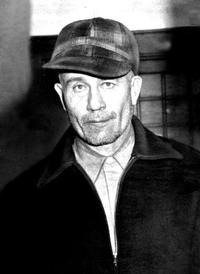April 12, 2018
The Man Who Inspired it All: Edward Gein

Edward Gein went from being known for being a sweet and innocent boy who would not hurt a fly to a murderer and a necrophiliac. Edward lived on a 195-acre farm in Plainfield, Wisconsin, with his parents Augusta and George Gain, and his older brother Henry. Gein’s actions caused him to be known as “The Butcher of Plainfield.”1 Edward’s father was an alcoholic and very abusive. Thus Edward grew up being extremely close to his mother. When his father passed away in 1940, Edward was not significantly affected by the loss, due to the lack of connection he had with his father. Four years later, his brother Henry passed due to a fire near their home; police suspected that Edward had had something to do with his death because he led them directly to his brother’s burnt body.2 The following year his mother Augusta also passed away, leaving Edward all alone on a big farm. After Augusta’s passing, Edward blocked off rooms in the house where his mother had spent most of her time, creating something of a shrine for her. With Edward being all alone it is said that this is what drove him into having psychopathic behavior.3
Edward’s first known victim was Bernice Worden in 1957. Worden worked in a hardware store in town. Edward went to the store as he usually did on Friday’s right before closing time, and asked Mrs. Worden to fill up his jug with antifreeze. Edward had recently started to question Mrs. Worden on whether or not she would like to go roller-skating or “try out the floor” in his words. When she declined, he left, and then he quickly returned to ask about a rifle she had on the wall. When Mrs. Worden handed Edward the rifle he desired, she proceeded to look out the window. While she had her back turned, Edward loaded the rifle with the .22 shells he had in his overall pockets. The next morning Bernard Muschinski, Sr. found something strange with Mrs. Worden’s store. It had seemed that the store had been closed for the weekend, but she had left the lights on, which was something she usually didn’t do.4

When police were tipped off by Mrs. Worden’s son that Edward was the one that had kidnapped and killed his mother, the police took off to find him. While Edward Gein was in custody, police officers went to explore his land to try and find Bernice Worden’s body. While examining the house for any signs of Mrs. Worden’s body, the two officers made their way into the summer kitchen and started making their way to the other side. Officer Schley stepped back and felt something rub against his jacket. When he beamed his light towards what was rubbing against him there, in the beam of light hung a large corpse. While looking at the body that was in front of them, they noticed that it was attached by its feet and was split open and decapitated the way a deer would be. Before running out from the sight of it, Schley had managed to get out a couple of words, “My God, there she is.” They had finally found the missing body of Bernice Worden. After other officers were called, they began exploring the central part of Gein’s house. While they were looking around the house, the officers found many ghoulish things, from a human skull to things like lampshades, wastebaskets, bracelets, and even a belt made from human body parts. Officers on the scene also found a chair upholstered from human flesh along with many other gruesome things. While being interrogated Gein was asked many questions regarding the strange things in his house, which he answered in a calm, truthful manner. When he was asked whether or not he would put on the skin face mask that was found in his home, Gein responded that he did without hesitation.5
With Gein admitting to the crimes and the evidence in his home, it was easy for the officers to charge him with murder. At the time of his trial, he was considered unfit to stand trial and was admitted to the Central State Hospital for the Criminally Insane in Wisconsin on January 6, 1958. After a decade of being charged with first-degree murder, Gein was finally considered to be fit to stand trial; he was then found not guilty because of insanity and went back to the State Hospital. Edward Gein’s crimes have subsequently become the basis for many Hollywood horror movies, including Psycho (1960), The Texas Chainsaw Massacre (1974), and Silence of the Lambs (1991).6
- Harold Schechter, Deviant: the shocking true story of the original “psycho” (New York, NY: Pocket Books, 1998), 61. ↵
- Encyclopædia Britannica, 2018, s.v. “Ed Gein,” by John Philip Jenkins. ↵
- Salem Press Biographical Encyclopedia, 2016, s.v. “Ed Gein,” by Charles Avinger. ↵
- Harold Schechter, Deviant: the shocking true story of the original “psycho” (New York, NY: Pocket Books, 1998), 67. ↵
- Harold Schechter, Deviant: the shocking true story of the original “psycho” (New York, NY: Pocket Books, 1998), 122, 124. ↵
- Salem Press EncyclopediaResearch Starters, EBSCOhost, 2013, s.v. “Serial killer,” by Kathy Warnes. ↵
Tags from the story
Edward Gain